Slade's Morgue:
Crucified
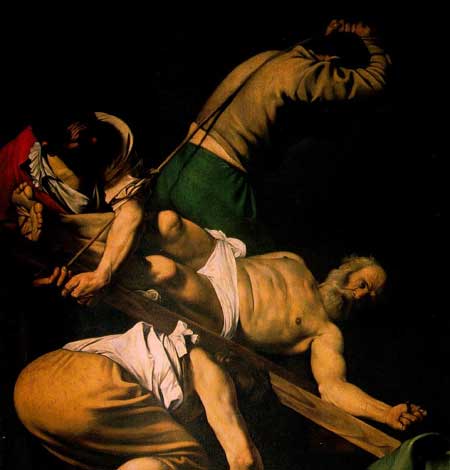
THE CRUCIFIXION OF ST. PETER by Caravaggio

THE CRUCIFIXION OF ST. ANDREW by Caravaggio
CRUCIFIED is Michael Slade's religious and locked room thriller. It's the first novel not to feature Special X. It introduces New York lawyer Wyatt Rook. Here's the story behind it. Let's start with a puzzle. What links the crucifixions above to the pictures below?
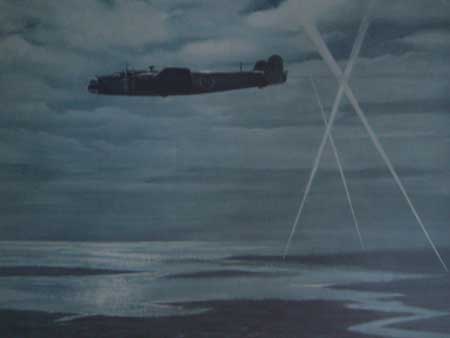
OUTWARD BOUND by Roy Nockolds

Flight Lieutenant Jack "Johnny" Clarke in combat

Newspaper photo of F/L Clarke snapped in North Africa on return from combat
The answer to that puzzle is this:

Canadian edition of CRUCIFIED


CRUCIFIXION by Salvador Dali

DEPOSITION by Rembrandt

DESCENT FROM THE CROSS by Rubens
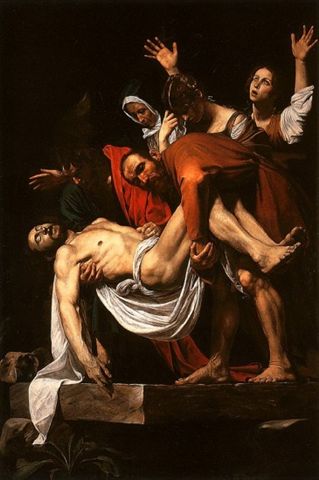
THE ENTOMBMENT OF CHRIST by Caravaggio

American, British, and Commonwealth edition of CRUCIFIED
"If you want a series of mysteries better than the puzzles in THE DA VINCI CODE, CRUCIFIED is your book. Slade has all the hot buttons punched." - The Globe and Mail.
"A smoking hot read. Prepare to be entertained. Slade conjures up a Christian's worst nightmare: Unravelling how Jesus Christ escaped from his ancient tomb. This slick whodunit about that historical mystery is full of twists and turns." - The CTV Network.
"CRUCIFIED creatively combines secular and religious milestones to pose a highly plausible threat to the Holy Church. Slade has successfully broadened to a new genre which combines crime fiction with that subtle nervous feeling you get when argument raises a reasonable doubt about a hitherto certainty - in this case, nothing less than your faith." - Joseph C. Bellows, Q.C., Criminal Appeals and Special Prosecutions Crown counsel, and Forensic Investigation instructor, in The Advocate.
As a boy, Slade was intrigued by locked room puzzles. First, there was the Hardy Boys, WHILE THE CLOCK TICKED (1932). Frank and Joe solve the mystery of the secret locked room in the Purdy Mansion. Then, "THE ADVENTURE OF THE SPECKLED BAND" (1892), which Sir Arthur Conan Doyle expressed to be his best Sherlock Holmes story. Then, "THE MURDERS IN THE RUE MORGUE" (1841), the world's first detective story, by Edgar Allan Poe. And then Slade discovered John Dickson Carr.

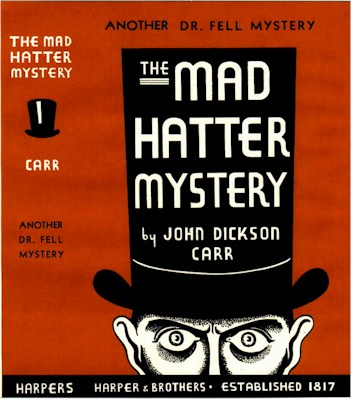

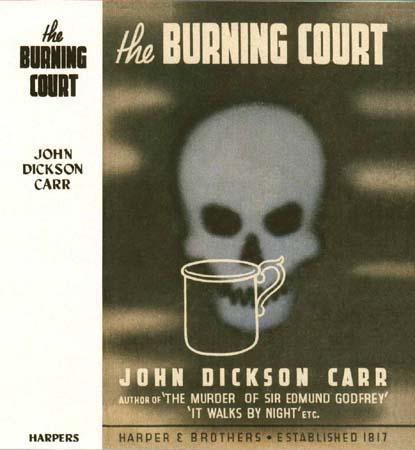
John Dickson Carr (1906-1977) is the undisputed master of the locked room puzzle. His prolific writing career produced more than eighty variants of that impossible crime. As an expatriate American, Carr - who also used the pen name Carter Dickson - lived in Britain from 1933 to 1948. His stories capture the creepy aspects of England. Though Slade was a fan of three Golden Age mystery writers - Christie, Queen, and Carr - his favorite was Carr. That's because JDC fused sleight-of-hand puzzles with Grand Guignol macabre.
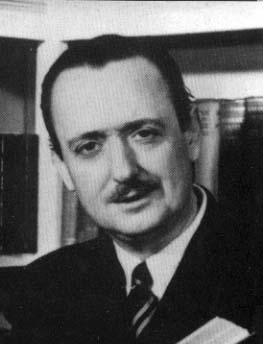
John Dickson Carr
A locked room puzzle is any crime committed in such a way that it seems impossible to determine how it was done. The classic setup is a corpse found within a "sealed" room or other enclosed space - death at close quarters surrounded by unmarked snow or wet sand - offering no way for a killer to enter and/or exit without being seen or leaving a trace.
Many consider Carr's THE THREE COFFINS (1935) - THE HOLLOW MAN in Britain - to be fiction's best locked room mystery. In it, Dr. Gideon Fell delivers what is now known as "the locked room lecture," a list of the seven possible solutions to murder committed in any place where the sole occupant seems to have been the victim:
- 1. It is not murder, but a series of coincidences ending in an accident which looks like murder.
- 2. It is murder, but the victim is impelled to kill himself.
- 3. It is murder, by a mechanical device.
- 4. It is suicide, made to look like murder.
- 5. It is murder, but the victim is already dead.
- 6. It is murder, committed outside the room but appearing to have been committed inside.
- 7. It is murder, but the victim is not yet dead.
Slade's copy of THE THREE COFFINS reflects its theme of vampires and premature burial.

Slade's first locked room puzzle was "The Iron Room" story in 13 TOMBES (see NOVELS and BLOG), written when he was twelve. Sometime in his teens, it occurred to Slade that finding the Tomb of Jesus empty after his crucifixion had all the elements of a locked room puzzle. His fourth novel, RIPPER, has a pair of locked room puzzles that elicited this welcome comment by Wooda H. McNiven, John Dickson Carr's grandson, in a lively discussion on a Website dedicated to JDC:
"Also, for those into modern day graphic serial killer stories, check out RIPPER by Michael Slade. RIPPER is not for the faint-hearted but there are a lot of references to John Dickson Carr throughout this novel as seemingly one impossible (and ultra-gruesome) killing takes place after another. As it is all rather fantastic and far fetched and arguably in the Grand Guignol tradition, and also a fair play whodunit, I suspect my grandfather would have given it two thumbs up."
CRUCIFIED is Slade's return to locked room puzzles. Three of them.
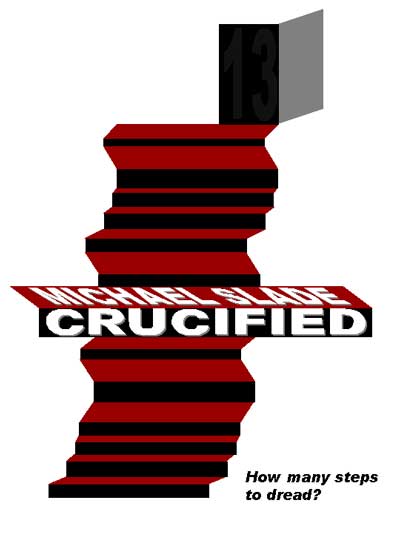
John Dickson Carr is said to have frequently used the expression "Improving one's mind with the study of sensational fiction." In Slade's opinion, there is no better training for a criminal lawyer than to sharpen his mind on the whetstone of locked room puzzles. Here, for example, is a murder charge Slade defended in his twenties.
Two men were drinking in a bar. One said he thought his wife was fooling around. It would be worth some money to him if her suspected lover was taught a lesson. The name of the "lover" was overheard by a drug addict at the next table. On spec, he and two friends went to earn the money. Jittered from a cocktail of drugs and booze, the three home invaders went berserk. They shot, stabbed, and clubbed the man (who actually wasn't the wife's lover) and his girlfriend to death.
Two of the men were convicted on overwhelming evidence. The trial concerned the identity of the third man. By chance, a suspicious neighbor had seen a strange car parked on a road near her house. By viewing the men through binoculars, she got a look at the soon-to-be killers. Though she picked out Slade's client at a lineup, the identification was tainted by the fact she had seen him being led into the police station in handcuffs. Thus, the trial focused on the physical evidence.
At the murder scene, police lifted fingerprints from a whisky bottle found on a counter. Neither victim drank whisky. In transporting the bottle from the house to the police station, the exhibit man placed it on the roof of his car while he loaded the trunk. Guess what happened? As he drove away, glass smashed on the road. Detectives, however, still had the lifts, which matched the fingerprints of Slade's client. No other prints from the home invaders were found at the scene.
Slade's client was arrested at a drinking party in the flophouse room of one of the other killers. The three accused knew each other, the prosecutor told the jury, and committed the murders together. Even if the jury discounted the ID evidence because of the taint, there was still the whisky bottle found at the scene. Slade's client took it there for "liquid courage," and addled by drugs and booze, inadvertently left it behind. The fingerprints proved beyond a reasonable doubt that he was the third killer.
If you were the defense lawyer, what would you tell the jury?

"Slade employs three locked room puzzles - crimes committed under seemingly impossible circumstances in locations that no intruder could have entered or exited - to concoct an entertaining thriller of biblical proportions. Eventually, tracing it all back to Jerusalem 33 A.D., Rook solves all three conundrums in a suspenseful globe-trotting pressure cooker of historical intrigue. Will do more for your brain than a crossword puzzle." - Rue Morgue.

Addressing a jury is two-thirds content and one-third showmanship. Slade learned that as a teen from the gallery of the Old Bailey, the best show seats in London and home to the trials of Oscar Wilde; the poisoner, Dr. Crippen; Haigh, the Vampire Killer; the treasonous Lord Haw Haw; Christie, 10 RILLINGTON PLACE; mobsters, the Kray Twins; Sutcliffe, the Yorkshire Ripper; and a slew of others.
"My lord," said Slade as he stood up to address the jury, "let the record show that I am placing a half-filled whisky bottle on the counsel table." The judge asked why? "This jury looks like a tough crowd and I might need liquid courage." The prosecutor picked up the bottle, uncorked it, and sniffed. "It smells like tea," he said.
Slade's answer to the bottle found at the crime scene was a reworking of Carr's explanation 6: It is murder, committed outside the room but appearing to have been committed inside, and explanation 7: It is murder, but the victim is not yet dead. What Slade had to do was involve his client elsewhere before the victims were dead, then insert someone else at the murders as the third killer. In charging the jury on the circumstantial evidence of the bottle, the judge (back then) had to instruct them on the Rule in HODGE'S CASE (1838): Before you can find the accused guilty on circumstantial evidence, you must be satisfied not only that the circumstances are consistent with him having committed the act, but also that they are inconsistent with any other rational conclusion than that he is the guilty person.
"My lord," said Slade, "let the record show that I'm pulling on a glove. What if my client put his prints on the bottle during an earlier drinking party in the flophouse room? What if three hit men - none of them my client - later donned gloves and went to the murder scene? What if one of those men took the bottle along for 'liquid courage?' And what if that man - not my client - left the bottle behind after the murders? Would that not better explain why no prints from the killers were found at the scene except on the bottle?"
At that point, Slade carried the mock bottle in his gloved hand across to the jury box and set it down on the rail.
"The judge will instruct you, members of the jury, on the Rule in HODGE'S CASE. As you listen, consider this. If my learned friend, the prosecutor, were charged with jury tampering, would you convict him because his fingerprints on that bottle on the jury box rail prove beyond a reasonable doubt that he took it to the jury box?"
Slade left the bottle on the rail. It could either sit there and haunt the prosecutor during the judge's charge. Or he could remove it and look like he had something to hide.
Thank you, John Dickson Carr.
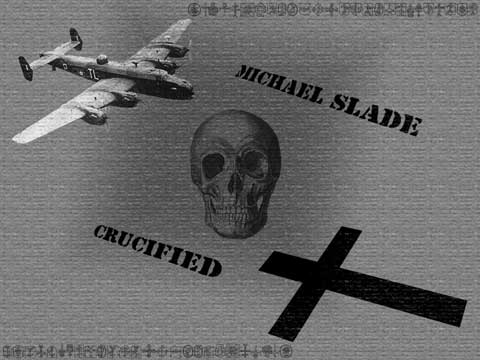
"Unfolds with effortless readability, despite the fact it ranges over two millennia and incorporates aspects of the Crusades and the witch hunts. There are twists aplenty, scenes of gruesome torture and murder (with Inquisition tools, of course), and a series of small mysteries leading up to the larger mystery at the centre of the book. It leaves one wanting more." - Quill & Quire.

2003 was the year that inspired CRUCIFIED. Two events occurred. Like much of the world, Slade read Dan Brown's THE DA VINCI CODE. And, in May of that year, Slade's mother died.
Though fully appreciative of the work that went into Brown's novel, Slade had three reactions. 1) The plot's threat to Christianity and the Catholic Church isn't the foremost lurking threat to the Christian religion. There's a far greater one. 2) Mathematics not being Slade's strongest subject, the puzzles didn't scream for him to solve them. 3) Given Slade's taste for sanguinary villains, he found Brown's albino monk rather benign.
In 1955, Slade's mother and father bought a split-level house. The following year, when Slade was nine, his dad died in a plane crash. For almost fifty years, his mom lived on in the house. When she succumbed to cancer in 2003, the house was sold. While cleaning it out, Slade removed the contents of the linen closet in the upper hall. The back of the closet was a false wall fronting the attic above the single level. In there, Slade discovered his father's archive from World War II, gathering dust since 1955.
To comprehend the effect on Slade, read the story of his father's death here. Losing a parent at age nine leaves hazy memories. Now, Slade had the means to delve into his dad's war record, and out of that odyssey would come two of the locked room puzzles in CRUCIFIED.
So, what's the greatest threat to Christianity? In Slade's opinion, it isn't this, from THE DA VINCI CODE.
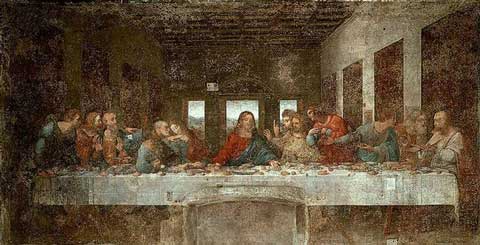
THE LAST SUPPER by Da Vinci
A criminal lawyer learns by experience to spot and go for the Achilles heel of his opponent's case. Applying that experience to the Christian Bible, Slade suggests the greatest threat to Christianity is in the painting below. Do you see it? Do you grasp the implications? Do you understand why the Vatican - for its survival - would need to suppress the secret, should it ever surface, as it does in CRUCIFIED?

THE LAMENTATION by Petrus Christus
"A downed World War II bomber is unearthed, launching a competitive search for a biblical secret that pits science against faith and threatens to bring down the Catholic Church.
"In a time-hopping adventure that's part INDIANA JONES and part DA VINCI CODE, this mystery pits a sinister papal representative, the Legionary of Christ, against lawyer-historian-and-bestselling-author Wyatt Rook and his new partner Liz Hannah, the sexy granddaughter of that lost bomber's pilot. The goal is to solve the mystery of why the British bomber was sent on a strange mission at the height of the war, and why that same bomber was hunted down over Berlin. At stake are the clues that will unravel the mystery of Judas, a hidden Nazi traitor, and possibly the future of mankind. But while the quest is far-fetched, Slade handles the balancing act well, drawing us first into the character of that bomber crew and then of Rook and Hannah, with believable dialogue and lots of bloody action.
"As far as historical, Vatican-connected occult thrillers go, this is a fun one, with the various timelines balanced to play off each other with verve." - Kirkus Reviews.
Here, from the novel, is a map of Jerusalem at the time Jesus was crucified.

Jesus - according to the Bible - told his twelve disciples at the Last Supper, "One of you will betray me."

THE LAST SUPPER by Gustave Dore
Later that night, in the Garden of Gethsemane at the foot of the Mount of Olives - number 1 on the map - Judas betrayed Jesus with "the Judas kiss."

THE JUDAS KISS by Gustave Dore
Sentenced to death, scourged, and wearing a crown of thorns, Jesus carried his cross along the Via Dolorosa from number 2 on the map to number 3: Golgotha. There, he was nailed to the cross...
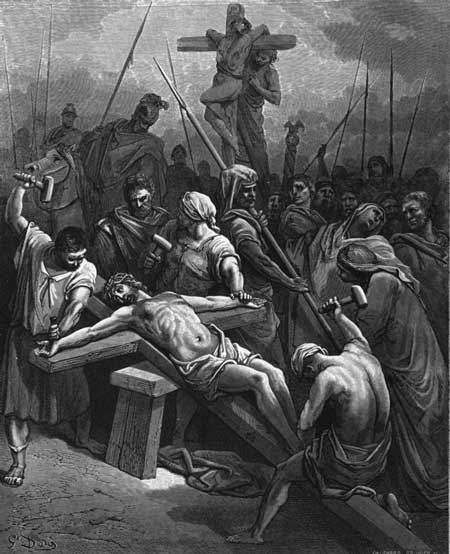
NAILING CHRIST TO THE CROSS by Gustave Dore
...died...
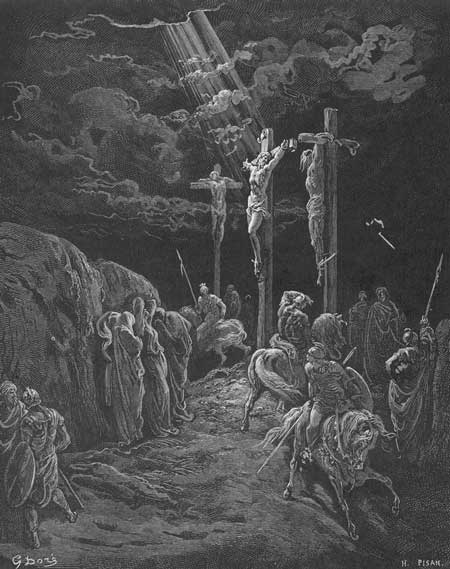
THE CRUCIFIXION by Gustave Dore
...and was taken down.

THE DESCENT FROM THE CROSS by Gustave Dore
Jesus was buried in a tomb - number 4 on the map - in the quarry beside Golgotha.

THE BURIAL OF CHRIST by Gustave Dore
The tomb of Jesus was sealed with a heavy stone and guarded. When it was entered days later, the body of Jesus was gone. And there you have all the elements of a locked room puzzle.
In addition to the threat illustrated above, what captured Slade's interest is the fate of Judas. Judas is the villain of Christ's crucifixion. The Bible says he suffered guilt, returned the thirty pieces of silver paid for his betrayal, and left the city for Haceldama, "the field of blood" - number 5 on the map - where he hanged himself with a halter, "burst asunder in the midst: and all his bowels gushed out."
So, what are we to make of the Gospel of Judas?

The Gospel of Judas
Haceldama - once an actual potter's field - became a burial place for strangers. That's where dead Crusaders were buried. And from Jerusalem, there has always been a caravan route along the north coast of Africa.

HACELDAMA
photo by Deror Avi, licensed copyright
What pulled CRUCIFIED together in Slade's mind was his father's war archive and PILOT'S FLYING LOG BOOK. Jack Clarke was born in Montreal in 1921. His teenage years were spent on the south coast of England, attending the Southampton School of Art on scholarship. Returning to Montreal, he worked for Associated Screen News as a commercial artist. In September 1940, at the height of the Battle of Britain, he volunteered to fly with the RAF. He was sent to Scotland to train as a bomber pilot. Because "Jack" came over the radio like a crack of static, he was nicknamed "Johnny." September 1941 saw him posted to Yorkshire with #10 Squadron. His first raid was to Nuremberg on the night of October 12.

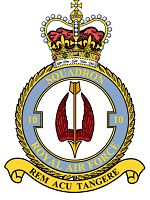
#10 Squadron crest

LOG BOOK: Inside Front Cover.
Caricature of navigator by Clarke

LOG BOOK: Raids on the Channel Dash
"ugly sisters" and U-boat pens
The Battle of the Atlantic raged in 1941 and 1942. U-boats - including U-96, the one in DAS BOOT (the best submarine film ever made) - were penned at St. Nazaire, France. Clarke raided St. Nazaire and the U-boat yards in Bremen, Kiel, and Wilhelmshaven.

Map: St. Nazaire harbor

St. Nazaire U-boat pens
photo by Ka Teznik, licensed copyright
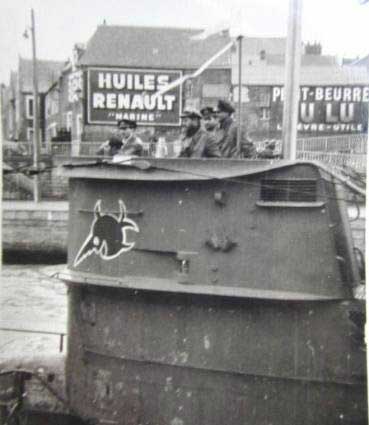
U-96: DAS BOOT
The great German surface raiders were the Bismarck, the Scharnhorst, and the Gneisenau. The Bismarck was sunk in 1941. The Scharnhorst and the Gneisenau were called the "ugly sisters" because they attacked together and sank 22 ships, including an aircraft carrier. On February 12, 1942 (see LOG above), they survived the Channel Dash back to Germany.

The Gneisenau (Bundesarchiv)

The Channel Dash
On the night of February 26, Clarke raided Kiel to destroy the Gneisenau. Bombing the bow section took the battleship out of the war. That marked the end of the German surface threat in the Atlantic.
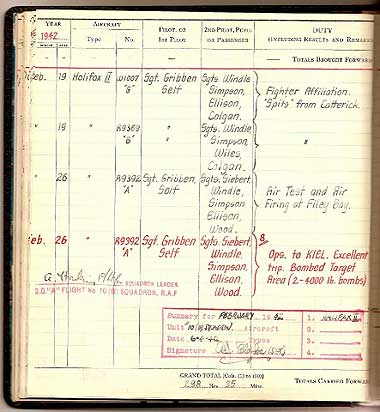
LOG BOOK: Destroying the Gneisenau

Kiel: Gneisenau in dock to the upper left

Kiel: Gneisenau hit

Kiel: Gneisenau damaged
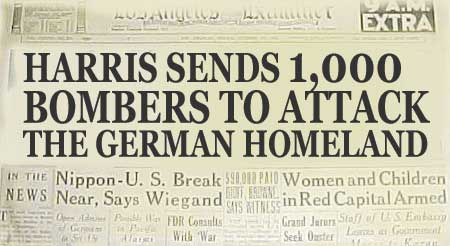
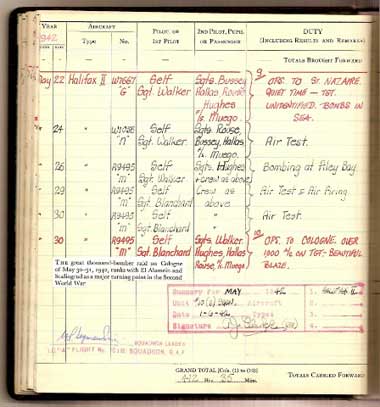
LOG BOOK: Thousand Bomber Raid on Cologne
The Thousand Bomber Raid on Cologne (Operation Millennium) marked a turning point in the War. It was followed by similar raids on Essen (June 1) and Bremen (June 25). Clarke flew in all three. Then, at the end of June 1942, his LOG contains the following note on secrecy. From clues above, can you guess where he's going and why?

The Handley Page Halifax was a monster of a plane. It was 70 feet long, 21 feet high, had a wingspan of 100 feet, a range of 1,900 miles, and it carried a bomb load of 13,000 pounds. Here is the reconstructed Halifax - Friday the 13th - in the Yorkshire Air Museum.

Friday the 13th Halifax bomber,
photo by Alan Zomerfeld, licensed copyright
Dubbed the "Halibag" by its crews, the heavy bomber was flown by seven airmen. Here's a photo of Clarke and crew standing in front of the bomb bay, under one of the wings.

Clarke and crew: Europe
Decades ago, it occurred to Slade that a murder committed in a Halifax bomber flying over Nazi Germany would make a good locked room puzzle. Each crew member had a combat position that he couldn't leave during a bombing run, and the seven men were in constant radio contact from the plug-ins at their stations. Later, as Slade read his father's FLYING LOG and tracked the various combat operations around the Internet, the outline of a locked room puzzle formed in his mind.
For CRUCIFIED, Slade created this seven-man crew:
F/L. Fletch "Wrath" Hannah (Pilot)
Sgt. Mick "Balls" Balsdon (Navigator)
Sgt. Hugh "Ox" Oxley (Flight engineer)
Sgt. Russ "Nelson" Trafalgar (Bomb-aimer)
Sgt. Earl "Sweaty" Swetman (Wireless operator)
Sgt. Dick "Ack-Ack" DuBoulay (Rear gunner)
Sgt. Trent "Jonesy" Jones (Mid-upper gunner)
First, let's position them within the novel's Halifax, The Ace of Clubs. Click here for a cross-section of the bomber.

Halifax II

Halifax II

Halifax III
"Nelson" - the bomb-aimer - is in the nose cone.
"Wrath" - the pilot - is in the upper level of the cockpit.
"Ox" - the flight engineer - is in the upper level seat to Wrath's right.
"Sweaty" - the wireless operator - is in the cockpit's lower level, behind the bomb-aimer.
"Balls" - the navigator - is also in the lower level, surrounded by a blackout curtain so he can read his maps.
"Jonesy" - the mid-upper gunner - is in the top turret halfway back.
"Ack-Ack" - the rear gunner, the "arse-end Charlie" - is in the tail turret.
Now, thanks to YouTube, let's climb aboard and fly. Click here.
And let's go into combat with actual bomber crews:
Click one, Click two, Click three.
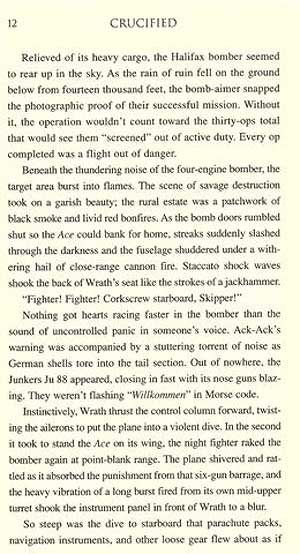



Who's the victim? Who's the killer? How was the murder committed? And why?
Liz Hannah, Wrath's granddaughter, hires New York lawyer and bestselling historian Wyatt Rook to get to the bottom of a rumored conspiracy behind the last flight of the Ace of Clubs. Before he encounters the locked room puzzle exposed by the resurrection of the long-lost bomber, Rook travels to Yorkshire to see one of the crewmen who survived being shot down. He finds the old man naked and skewered on a Judas chair, so-named because the Inquisition torture device disemboweled its victims like Judas at Haceldama: he "burst asunder in the midst: and all his bowels gushed out."
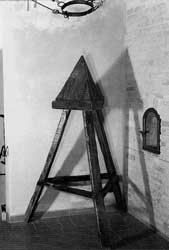
Judas chair


Unknown to Rook, the pear is waiting for a future victim.

The Pear

"BOOK OF THE MONTH. Slade is unleashing his most serpentine - and perhaps most dangerous - literary beast, the Satanic shocker CRUCIFIED. A walloping murder mystery that cuts throats and shows no quarter. Slade's grip on claustrophobic, clammy suspense sequences is masterful. Ambitiously dark, sophisticated, and complex. Enjoy." - Fangoria.
"CRUCIFIED delivers a reliable trio of mystery, sex, and gore. The plot moves at breakneck speed. Enjoy the ride." - Precedent.
"Those with an insatiable appetite for DA VINCI CODE-type conspiracy thrillers will be most rewarded. - Publishers Weekly.
"Rich in historical detail, CRUCIFIED is a satisfying read for relic hunters, history buffs, and thriller readers. It moves at breakneck speed through time from first-century Jerusalem to the battlefields and boardrooms of WWII to present-day Europe. Highly recommended." - Hamilton Public Library.
"Lawyer and historian Wyatt Rook and his gal pal Liz Hannah are up on all the latest tricks of the trade. There is gore to the armpits, some fine lunatics, a touch of heresy, and a fiendish religious cabal that will stop at nothing to keep the world from discovering that the New Testament may just be hogwash." - The Globe and Mail.
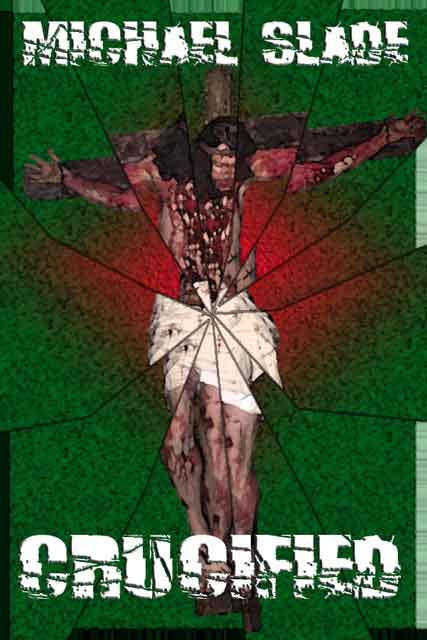
So, did you catch the "Secrecy" clues to where Slade's father was going and why? The date June 1942, the combat photo "snapped in North Africa," and the clothes of the crew in the bottom photo inside the FLYING LOG?
Here's the answer to where and why.

NORTH AFRICA map
by Stephen Kirrage, licensed copyright

Rommel in North Africa:
June 1942 (Bundesarchiv)

Panzer tanks in the desert
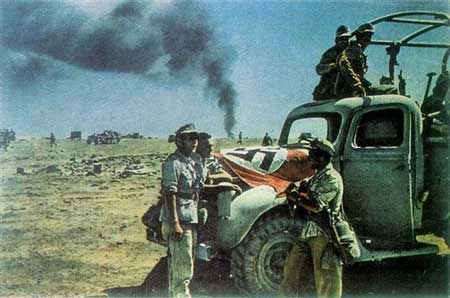
Afrika Korps in combat
After a lengthy tank battle known as "the Cauldron," Field Marshal Erwin "The Desert Fox" Rommel's Afrika Korps seized the British stronghold of Tobruk on June 21. A Roman fort on the caravan route in biblical times, Tobruk was a crucial supply port in North Africa.
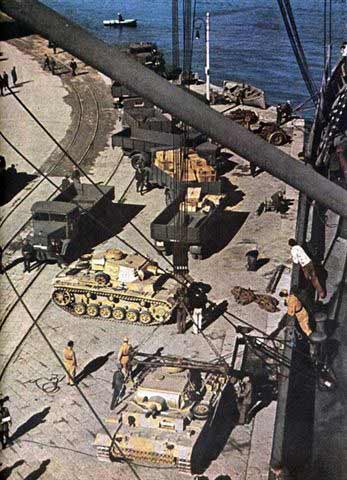
Off-loading Afrika Korps tanks at Tobruk
The retreating British Eighth Army (including "the Desert Rats") dug in at the bottleneck coastal railway station of El Alamein to make a last stand. A war machine runs on oil. If El Alamein fell, Rommel would take the Suez Canal to dominate the Mediterranean, and press on to capture the rich oil fields of the Middle East. On June 30, he attacked El Alamein.
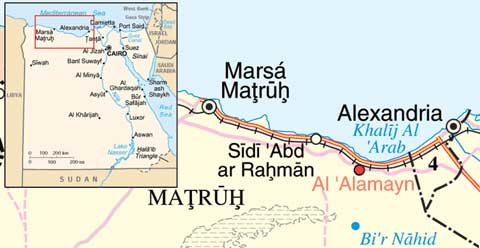
Map: El Alamein (Al 'Alamayn)
In total secrecy, #10 Squadron dispatched 16 Halifaxes and crews to the Holy Land. Landing at Aqir, Palestine (now Tel Nof Airbase in Israel), and raiding from "advance bases" in Egypt, Clarke and crew attacked Tobruk repeatedly from July 12 on, bombing the harbor, jetties, and warships to cut Rommel's supply line to the First Battle of El Alamein, July 1-27, 1942.
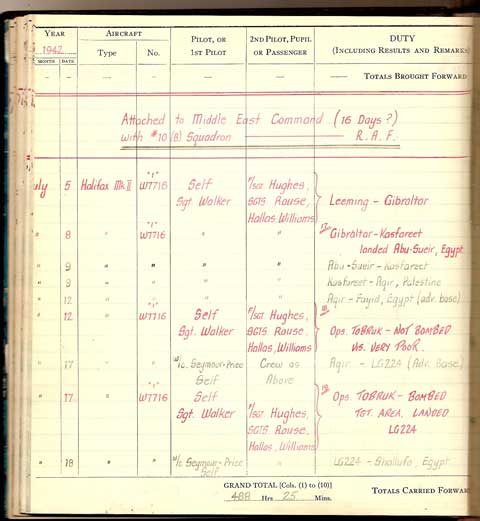
LOG BOOK: Sent to the Holy Land (16 days?)

Secret map: Aqir, Palestine
An advance base was little more than a tent in the desert. Clarke and crew lived with their plane. Water was in short supply.
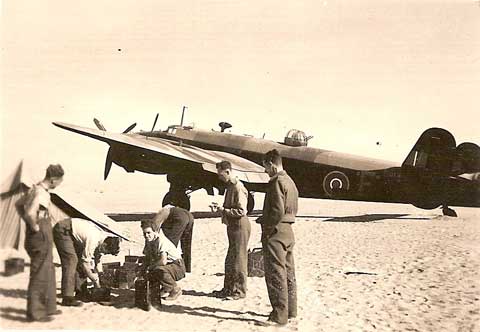
Advance base in the Egyptian desert
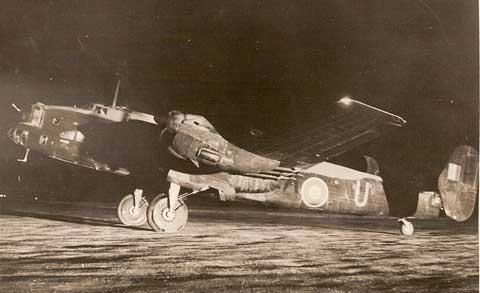
Clarke and crew's "Halibag"
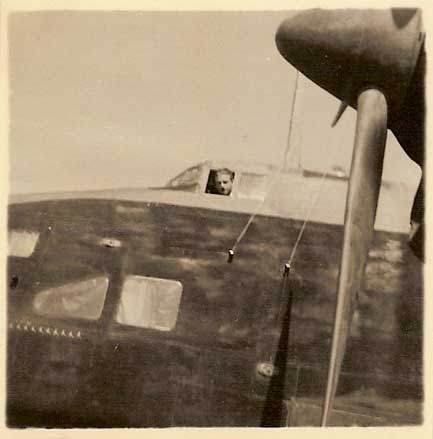
Clarke in the cockpit
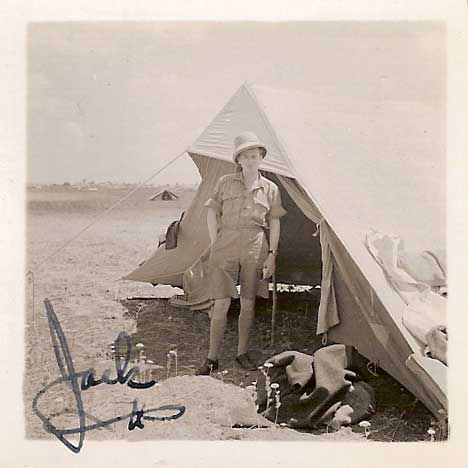
The skipper at home

Clarke and crew: North Africa
Rouse, Clarke, Hughes
Walker, Hallas, Williams

Hughes: Caricature by Clarke
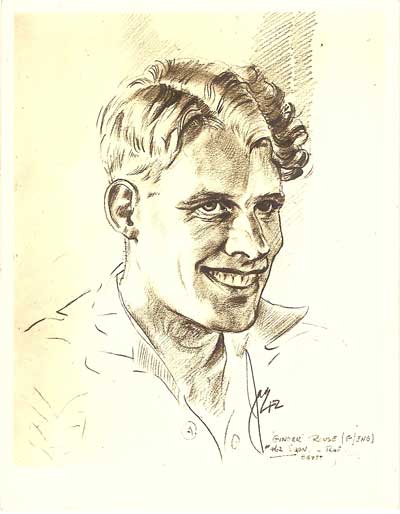
Rouse: Sketch by Clarke
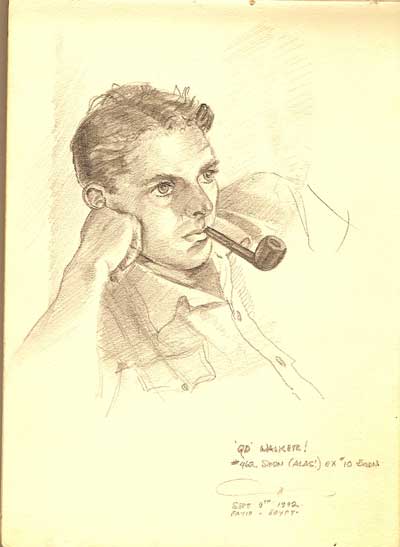
Walker: Sketch by Clarke
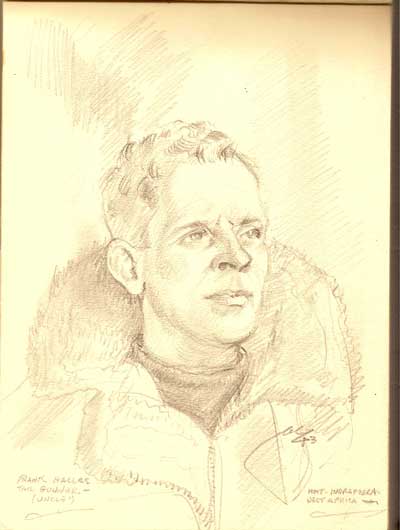
Hallas: Sketch by Clarke
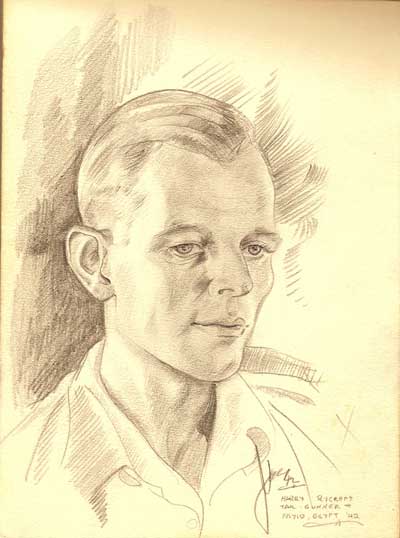
Rycroft (new tail gunner): Sketch by Clarke
With the "Muddle" East on the brink of strategic disaster, the Eighth Army got a new commander on August 13: Lieutenant-General Bernard "Monty" Montgomery.
The Second Battle of El Alamein began on October 23, 1942. In preparation, Clarke and crew struck the Luftwaffe airfield in Maleme, Crete, then joined the conflict.
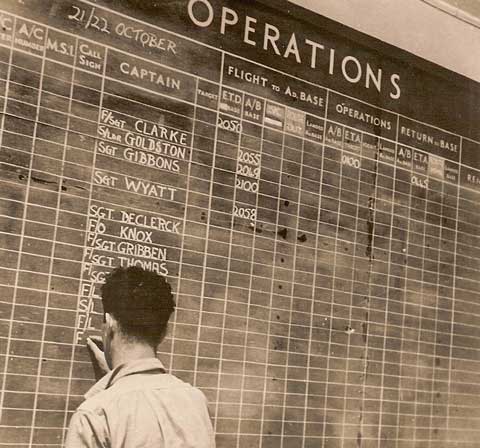
October 21: Clarke on operations board
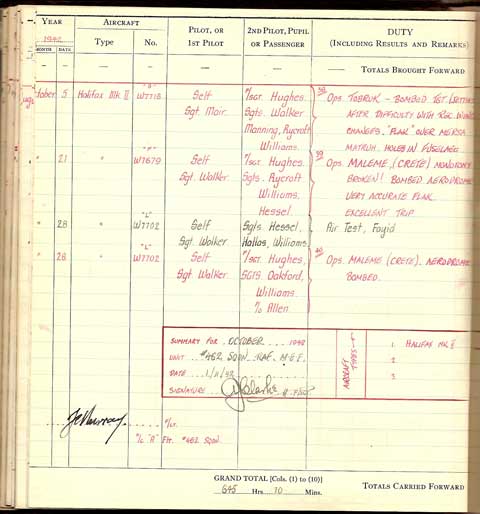
LOG: The Second Battle of El Alamein


On November 11, the day after their last raid on Tobruk, the fortified port was recaptured.

On the street in Tobruk, Clarke's photo
of Williams, Hallas, and Rouse
The retreat of the Afrika Korps was one of the longest in history. They followed the route of the Jews, Romans, and Christians in biblical times, and the Muslims and Crusaders in the Middle Ages. Many consider El Alamein the turning point in the War. As Winston Churchill put it, "Before Alamein we never had a victory. After Alamein we never had a defeat." On November 10, he said, "This is not the end. It is not even the beginning of the end. But it is, perhaps, the end of the beginning."
For Slade's father, that was the end of combat. His "16 days?" in the Holy Land stretched to eight months. In March 1943, he returned to Yorkshire to train other pilots. (See SWASTIKA.)
In 1974, Slade and his wife toured Britain. Driving north from London, they stopped in York. His mother had told him that's where "Ginger" Rouse lived, so Slade looked him up in the phone book and called. After ten rings, he was about to hang up when there was a last-second answer. Rouse and his wife were just back from vacationing in France, and the phone was ringing as they approached the door. Slade introduced himself, and Rouse asked if they'd had dinner. Slade said no, so Rouse asked, "What do you like to eat?" Slade replied, "Since we're in York, I guess it should be roast beef and Yorkshire pudding."
They met at the Black Swan. A medieval timbered guest house and pub that dates from 1417, it's reputed to have a ghost in a bowler hat that prowls the halls.

The Black Swan, York
Roast beef wasn't on that night's menu, but the chef wheeled out a silver-set cart to serve them that meal personally. For hours, Rouse told Slade stories about his dad's war. The Halifax crew was all British, except for the pilot, so "Johnny" was "adopted" by their families. When Walker got married, Clarke was his best man. Since Rouse was the flight engineer, he shared the upper cockpit with Slade's dad. They logged more than 300 hours of flying time together, lived in a Nissen hut at the Yorkshire airfield, and chummed around every minute of those eight months in Africa. They went through searchlight "conings" with blistering flak attacks, cannon strafing by night fighters, and engine stalls in combat. Also, they lost friends. (Note the operations board, and the name Goldston under Clarke. See "Goldie missing" in the LOG BOOK on November 10?)
Life in the desert was enough to drive you mad. The heat and the flies! The crew returned from a "hairy" raid on Tobruk with ack-ack gun holes peppering their plane. Inspecting the advance camp was one of the brass known to always travel with a personal cocoa-making machine. Somehow, it disappeared, prompting threats of a court-martial.
"Your dad," said Rouse, "was known for his humor and his pranks."
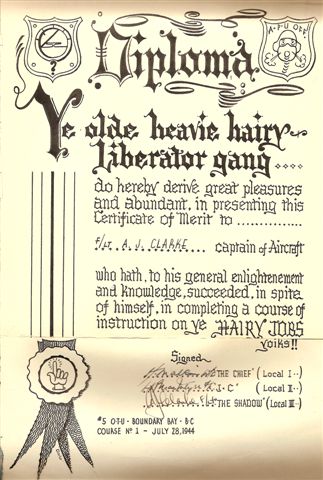
Diploma drawn by Clarke for pilots he
trained (some from #5 OTU destroyed
the Bridge on the River Kwai)
(Note: By 1944, Slade's dad was flying the American B-24 Liberator and B-25 Mitchell, training pilots in British Columbia for Burma and the Far East. His flying skills were so precise that he was dubbed "the Shadow." Farmers complained - the joke went - that his plane's shadow always crossed the same part of their fields, stunting their crops.)
The night the cocoa-maker vanished, Clarke invited the crew into his tent. Each man got a tin cup. "If we're going to die in this godforsaken desert," he said, "my crew can damn well buy it with the taste of cocoa on their lips."
"We sat in the dark," said Rouse, "sipping and thinking of our moms serving us cocoa as boys. In yet another miracle in the Holy Land, the next day saw the cocoa-maker back where it had vanished."
Dinner at the Black Swan over, it was time to part. Slade thanked Rouse and told him he shouldn't have gone to all the bother of having the chef prepare a special roast beef dinner. Ginger's final comment was, "Fighting a war together creates strong friendships. Against the odds, your dad flew me into the mouth of hell, and brought me home alive. It's the least I can do for his son."
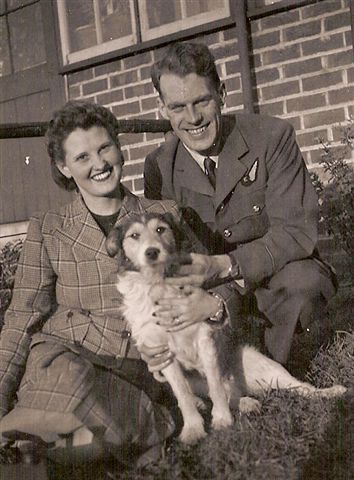
"Ginger" Rouse, back home
Decades later, Slade found his father's photo album in the attic archive. Leafing through the snapshots of the crew that flew the Halifax in Europe and North Africa, he saw the biblical caravan route from Haceldama to the Roman fort at Tobruk, and wondered what attacks by Rommel and the Halifax might have revealed. The result is CRUCIFIED.
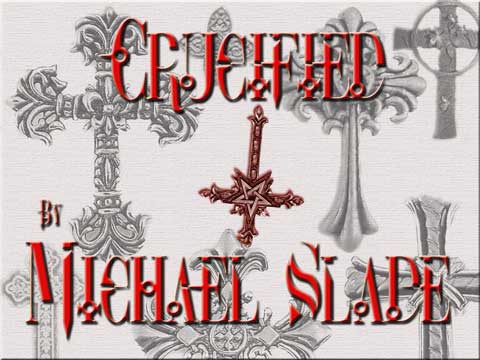
Where would Christianity in general, and the Catholic Church in particular, be without Satan and hell? If eternal bliss in heaven with God and Jesus is the carrot that keeps the faithful from sinning, eternal damnation with Satan in hell is the stick.

THE LAST JUDGMENT by Hieronymus Bosch

HELL: LES TRES RICHES HEURES DU
DUC DE BERRY by the Limbourg Brothers
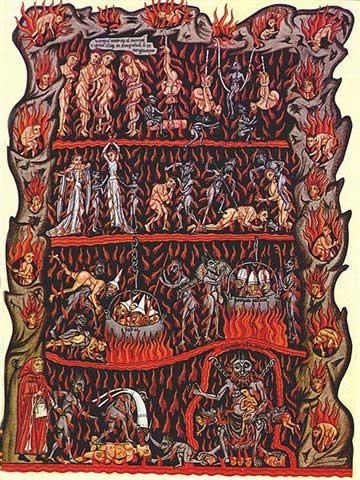
HELL by Herrad of Landsberg

LUCIFER, KING OF HELL by Gustave Dore

SATAN DEVOURING THE DAMNED IN HELL
by Fra Angelico
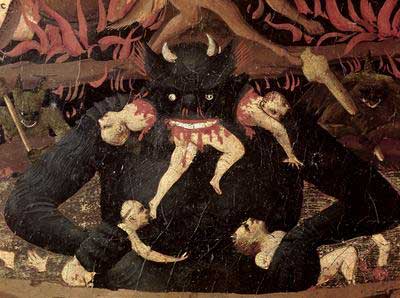
SATAN DEVOURING THE DAMNED IN HELL (Detail)

HELL (Detail) by Georgios Klontzas

THE DAMNED by Frans Francken

HELL by Hans Memling
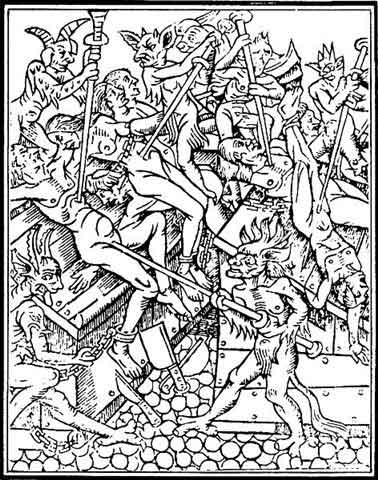
THE TORMENT OF THE NAILS
by Jean Cantarch

DANTE AND VIRGIL IN HELL
by William Adolphe Bouguereau
The Roman Catholic Church has always been under threat from Satan and his demons. When Slade was in his teens, a backpacking student could literally tour Europe on less than $2 a day. A superb network of youth hostels cost 25 cents a night. The hostel in Vienna was deep underground in a WWII bomb shelter. The hostel in Stockholm was a sailing ship moored in the harbor. The hostel in Bergen, Norway was up the mountainside. From the Louvre in Paris to the Hermitage Museum in Leningrad (now St. Petersburg) to the Vatican in Rome, Slade combed all the major museums, churches, and galleries. In St. Peter's Square, he attended an audience with Pope Paul VI.
That same year, Slade read ROSEMARY'S BABY by Ira Levin. Satan selects a lapsed Catholic to spawn the Antichrist. Not long after came William Peter Blatty's THE EXORCIST. A demon possesses a young girl in America.
The thrust of most religious art and literature is that Satan seeks to possess the bodies and souls of the living for eternal damnation in hell. Holding the line against the Devil in that endless tug of war stands the Roman Catholic Church and its priests.
Question: If you were Satan, who would you try to possess?

ST. WOLFGANG AND THE DEVIL
by Michael Pacher

THE EXPULSION OF THE DEVILS FROM
AREZZO BY ST. FRANCIS OF ASSISI by Giotto

ST. FRANCIS BORGIA PERFORMING AN EXORCISM
by Goya
The Catholic Church was relentless in its hunt for demons, witches, and heretics. The tribunal used to find them was the Inquisition. The conservative estimate is that hundreds of thousands were sent to the torture chamber and the stake because they were possessed by, or familiar with, Satan and his legion from hell.

Baphomet, from Eliphas Levi's
DOGME ET RITUEL DE LA HAUTE MAGIE

EL CONJURO O LAS BRUJAS by Goya

WITCHES by Baldung Hexen

LA SORCIERE by Martin van Maele
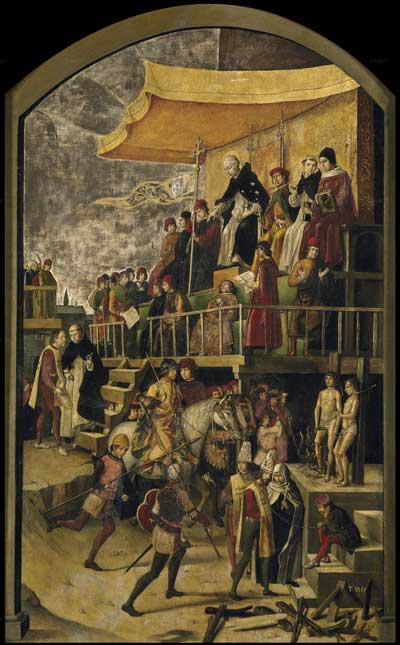
ST. DOMINIC PRESIDING OVER AN AUTO-DA-FE
by Pedro Berruguete

THE TRIBUNAL OF THE INQUISITION
by Goya

GALILEO FACING THE ROMAN INQUISITION
by Cristiano Banti

JOAN OF ARC IS INTERROGATED BY
THE CARDINAL OF WINCHESTER
by Paul Delaroche

Inquisition: Manual

Inquisition: Witch's chair

Witch's chair in use

Inquisition: The wheel

Inquisition: The head crusher

Inquisition: Torture chamber
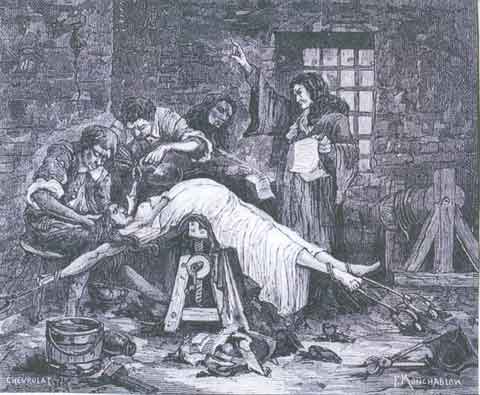
Inquisition: Waterboarding

Waterboarding (note the scribe)

Inquisition: The rack

Inquisition: The spinning wheel

Inquisition: Hanging with weights

Inquisition: Strappado

Punishing witches

ABBILDUNG AUS DER WICKIANA by Johann Jakob Wick


The Inquisition kept meticulous records of the confessions extracted from suspected satanists, witches, and heretics. Those records were shelved in the Palace of Sant'Uffizio - the headquarters of the Supreme Sacred Congregation of the Universal Inquisition - at the Vatican in Rome. In 1908, the Inquisition was renamed the Supreme Sacred Congregation of the Holy Office. In 1965, the Holy Office was renamed the Congregation for the Doctrine of the Faith, the name it has today. The Palace of Sant'Uffizio - now called the Palace of the Holy Office - is still the world's largest library of satanism, witchcraft, and sorcery.
The home of the Inquisition is circled on this photo.
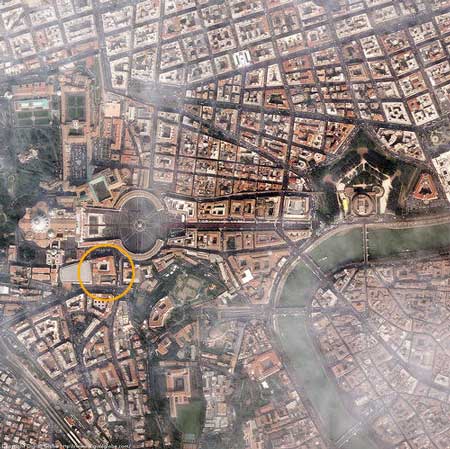
The Inquisition, the Vatican, Rome
(Digital Globe, licensed copyright)

From the Dome of St. Peter's Basilica.
The Inquisition palace is in the lower right corner.
Photo by David Iliff, licensed copyright

Palace of the Holy Office, the Inquisition today

The Palace of Sant'Uffizio during the Inquisition
Do you know why the Vatican was built where it is?
In ancient times, the area was called the Vaticanus. Known for its malarial mosquitoes, snakes, and sour wine, it was a marshy, hilly waste across the Tiber River from Rome. That's where the mad emperor Caligula decided to build his circus. On the spina - the central hub around which chariots would race - he erected an obelisk brought from Egypt. Caligula got assassinated, so Nero finished the job. The Circus of Nero became his favorite playground. When Rome burned for nine days in 64 A.D., he blamed the Christians. They were dragged to the circus to be torn apart by wild beasts, immersed in tar and set ablaze as torches, or crucified.

CHRISTIAN DIRCE by Henryk Siemiradzki.
Nero with an executed Christian woman in his circus
One of those crucified on the spina was Peter, the lead disciple of Jesus. He had come to Rome in Caligula's reign to spread the word of Christ. Because he felt unworthy to hang upright as Jesus did, Peter asked to be nailed upside down to his cross. See THE CRUCIFIXION OF ST. PETER by Caravaggio above. Later, he was secretly buried in the cemetery abutting the north wall of the circus.
Before the Battle of Milvian Bridge (312 A.D.) that secured him as Rome's emperor, Constantine the Great had a vision of a cross superimposed on the sun, and heard the words "By this sign, you will conquer." He had his soldiers mark their shields with the cross of Christ, and when he won, attributed victory to the God of the Christians.

CONSTANTINE AT THE BATTLE
OF MILVIAN BRIDGE by Raphael,
in the Vatican Rooms
Overnight, the Church of Christ was transformed from an underground sect to the official religion of Rome. Constantine built the Church of the Holy Sepulcher above the tomb of Jesus in Jerusalem, and St. Peter's Basilica above the tomb of Peter in Rome. In the Gospel of Matthew, Jesus says to his lead disciple, "You are Peter, and upon this rock I will build my church..." So, in the form of the Vatican, that passage from the Christian Bible assumed literal meaning.

St. Peter's Basilica at the Vatican,
built on the Circus of Nero
On the map:
1) Egyptian obelisk on the spina of the Circus of Nero.
2) Where St. Peter was crucified upside down.
3) St. Peter's Tomb under the altar in the Vatican's Basilica.
Today, when the pope stands at the altar of St. Peter's Basilica, a continuous succession of 265 popes stretches between him and St. Peter, the first pope of Rome, who lies buried in the shrine sixteen feet beneath his shoes. Jesus said to Peter, "I will give you the keys to the kingdom of heaven..." Note in the photos above that St. Peter's Square is shaped like a keyhole. At the center of the square stands the obelisk moved from the spina of the Circus of Nero on which Peter was crucified.
The Palace of the Holy Office - home to the Inquisition and rituals to conjure Satan recorded in its archives - was literally built on top of the field of blood that once soaked the Circus of Nero. If you've read the same books Slade has, and seen the same movies, you know the perils of building something on top of a pagan graveyard. Demonic possession lurks.
The first whiff of fire and brimstone was the brouhaha over Harry Potter. From 1982 to 2005 - the year he was elected Pope Benedict XVI - Cardinal Joseph Ratzinger led the Congregation for the Doctrine of the Faith (successor to the Inquisition). A conservative theologian, Ratzinger voiced strong views about the Devil and exorcism. He saw the Harry Potter novels as "a subtle seduction, which has deeply unnoticed and direct effects in undermining the soul of Christianity before it can really grow properly."
The Vatican's Chief Exorcist - Father Amorth - put it more bluntly: "Behind Harry Potter hides the signature of the king of the darkness, the Devil."
The flames of hell could be seen in the case of the Beasts of Satan, a heavy metal Satanic cult that sank into ritual murder. The Vatican responded to such devilish threats by training hundreds of new exorcists at Rome's Regina Apostolorum, a pontifical university run by the conservative Legion of Christ. "Thanks be to God that we have a Pope who has decided to fight the Devil head-on," said the Chief Exorcist.



Given that dark climate at the Vatican, can you imagine a troubled young priest - one of the Legion of Christ - sitting in a secret room at the Palace of the Holy Office, on top of that pagan field of blood and adjoining graveyard, surrounded by Inquisition records containing Satanic incantations that open the gates of hell?
Satan tried to get Jesus.

THE TEMPTATION ON THE MOUNT by Duccio
Satan tried to get St. Anthony.

THE TEMPTATION OF ST. ANTHONY by Hieronymous Bosch
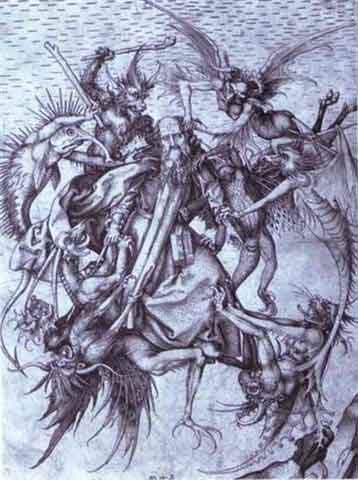
THE TEMPTATION OF ST. ANTHONY by Martin Schongauer

THE TEMPTATION OF ST. ANTHONY by Cezanne

THE TEMPTATION OF ST. ANTHONY by Dali
So, back to the question: If you were Satan, who would you try to possess? A lapsed Catholic like Rosemary? An American girl like Regan MacNeil? Or would you go for one of the priests trying to thwart you, like those in the Legion of Christ training hundreds of modern exorcists at the Vatican's Regina Apostolorum?
Is there any reason for an unstable priest in the Legion of Christ to worry that Satan might be trying to possess him?

TORMENTED BY DEMONS by Ambroise Fredeau
(Photo by Guerin Nicolas, licensed copyright)
In the Christian Bible, Jesus performs an exorcism on a demoniac: the possessed Gerasine.

HEALING OF THE DEMON-POSSESSED
When the demon is challenged by Jesus, what does it say?
"For he said unto him: Go out of the man, thou unclean spirit. And he asked him: What is thy name? And he saith to him: My name is Legion, for we are many." - Mark 5:8-9
"Jesus asked him, saying: What is thy name? But he said: Legion. Because many devils were entered into him." - Luke 8:30
Here's the Legionary of Christ in CRUCIFIED. You decide if he's possessed or psychotic.


"CRUCIFIED offers plenty of controversial material in the persona of its chief villain, a drooling-mad, possibly Satanically possessed priest dispatched by the Church itself." - Fangoria
"On Wyatt Rook's trail is a possessed priest known only as the Legionary, who's quickly racking up a gruesome death toll of people related to the bomber's crew. Using medieval tortures to silence informers, the Legionary is intent on stopping Rook from solving the Judas puzzle. Fans of Dan Brown's ANGELS & DEMONS and THE DA VINCI CODE will undoubtedly find this a comparable page-turner." - Rue Morgue

Back when he toured Europe on $2 a day, Slade stuck out his thumb on a rainy Sunday morning to hitchhike north from Nottingham, England to Scotland. A monstrous lorry with lots of gears picked him up. To say the driver was taciturn is an understatement. He didn't speak more than 100 words on the long haul. Eventually, the road hit a T in Scotland. The sign to the left said "Glasgow." The sign to the right said "Edinburgh." Slade asked, "Which way should I go?" The driver hooked his thumb right.
Luckily, Slade got picked up by an Edinburgh lawyer. They're still friends. Several times, Slade returned to the Firth of Forth, and poked around the towns near his friend's Haddington home. One was North Berwick.

The Firth of Forth
On the Map:
1) Arrow points up to St. Andrews.
2) North Berwick.
3) Isle of May.
Andrew - like his brother Peter - was a disciple of Jesus. After Christ was crucified, he preached the gospel in Greece, and angered the Roman governor by converting his wife. The result was THE CRUCIFIXION OF ST. ANDREW by Caravaggio above.
Legend says an angel told a monk named St. Rule to carry St. Andrew's bones to the "ends of the earth." Back then, Scotland was about as far as you could go. The monk got shipwrecked off the coast just north of the Firth of Forth. He built a shrine for the relics at what is now St. Andrews. That's why St. Andrew is the patron saint of Scotland. The X on Scotland's flag is his crucifixion cross.
Pilgrims from England flocked north to worship St. Andrew's relics. In the Middle Ages, they crossed the Firth by ferry from North Berwick. Auld Kirk - a church - was built in its harbor so they could pray for safe passage.

North Berwick harbor. Auld Kirk is the small
white church fronting the seaside green.
Photo by Lee Kindness, used by permission.

North Berwick seen from near Auld Kirk
On Halloween, 1590, Auld Kirk became the site of an infamous witches' Sabbath when the Earl of Bothwell summoned 200 warlocks and witches there to conjure the Devil up from hell. That sparked a witch hunt that sent to the stake 1,500 suspected Scots Satanists, many of whom were burned on Edinburgh Castle's esplanade. The Witches' Well, a fountain embossed with a snake, marks the spot today.

Black mass at Auld Kirk
In World War II, the overall death rate in RAF Bomber Command was 45%. The death rate of submariners in German U-boats was 75%.
The War saw innovations big and small. Below are the buttons off the fly of the pants Slade's father wore for combat raids.

See the small spike sticking up from the single button? It's a pivot. Place the button marked with two close dots along its rim on the pivot and it will swivel around so the magnetized dots point due north. If Slade's dad got shot down behind enemy lines, he could cut the buttons off his fly and use them to make a compass for escape.
Near the end of the War, the Germans revolutionized submarine design with the Type XXIII Elektroboot. Instead of diesel engines, it ran on batteries, and could stay submerged for 194 nautical miles. That meant it couldn't be "starved out" by surface pursuers. The sub was half the size of U-boats that began the War, and had a crew of fourteen.

Type XXIII Elektroboot (Bundesarchiv)
Legend says the Isle of May is where the Knights Templar stashed their treasure before being burned at the stake for heresy on Friday, October 13, 1307. That's the origin of paraskavedekatriaphobia: fear of Friday the 13th. The Isle of May is also where the last merchant ships - Sneland I and Avondale Park - were sunk by a Type XXIII U-boat less than an hour before the end of the War.
An Elektroboot - the Black Devil - prowling the Firth of Forth poses the third locked room puzzle in CRUCIFIED.
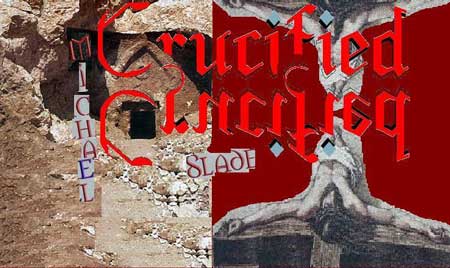
So, that's the story behind CRUCIFIED.
John Dickson Carr called it "the grandest game in the world." The chess game between writer and reader to see who can better the other over puzzles in a fair-play mystery novel.
In the beginning, Slade thrilled at the challenge of trying to beat Agatha Christie at her whodunits, Ellery Queen at his dying messages, and John Dickson Carr at his locked room puzzles. He would read those brain-twisters with pen and paper at hand, jotting ever-changing guesses to beat them to the punch. So, do you want to play the grandest game in the world?
1) What's the greatest biblical threat to Christianity and the Catholic Church?
2) Can you solve CRUCIFIED's three whodunits (one historical)?
3) Can you solve CRUCIFIED's picture puzzle: a painting in New York's Metropolitan Museum of Art?
4) Can you solve CRUCIFIED's map puzzle: Jerusalem?
5) Can you solve CRUCIFIED's three locked room puzzles: the Ace of Clubs, the Black Devil, and the tomb of Jesus?
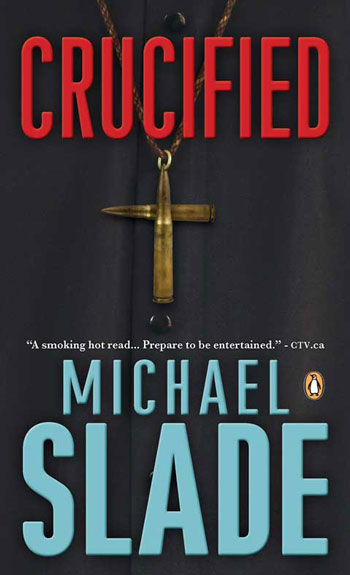
Canadian edition of CRUCIFIED














